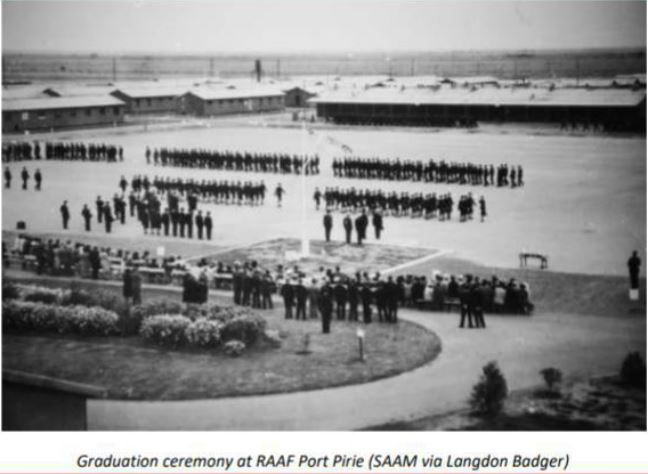No. 2 Bombing & Gunnery School RAAF
From Our Contribution
 Port Pirie, SA. c. May 1943. Group portrait of RAAF Navigators at No.2 Bombing and Gunnery School during their bombardier and air gunner course. | |
 | |
Brief History
This unit was established on 15 Jun 1941 under the Empire Air Training Scheme at Port Pirie, north of Adelaide, South Australia. Obvious advantages of the Port Pirie location were available space and good flying conditions year round with good weather and relatively benign terrain. The Port Pirie site had been extensively developed such that it could accommodate hundreds of men and dozens of aircraft. Its function was to provide bombing and gunnery training for pilots, air observers and air gunners. The period of training for each category was different, with pilots training for two weeks, air observers for eight weeks and air gunners for four weeks. By the end of 1943, the School had trained nearly 3,500 personnel. the vast majority being wireless air gunners.
The unit's first aircraft were Fairey Battles, arriving on I Jul 1941 and the first recruits started training at the School the same day. The air gunners were trained in Avro Ansons, firing upon drogues dragged behind Fairey Battle aircraft. The Fairey Battles flew along at 150 km/h whilst the Anson pilot swept back and forth under the drogue to simulate the curve of attack of a fighter a1rcraft. One exercise involved the trainee firing 300 rounds of colour tipped bullets at the drogue under the watchful eye of the gunnery instructor. The drogue was then winched back most of the way 1nto the Battle where it was then released to fall into a cleared area, to be collected by members of the WAAAF in the Armament Section. The holes then were counted to give a score. As live ammunition was used, accidents were bound to occur, but it was the aircraft themselves that were to cause the majority of incidents at Port Pirie.
While the aircraft used by the School included the Fairey Battle and Avro Anson, a number of Wirraway, Ryan, Gypsy Moth and Tiger Moth aircraft were also allotted to the unit. 2 BAGS strength peaked in June 1943 when it was operating 119 Fairey Battles, three Ryan Trainers and a Gypsy Moth; a handful of Wirraways were also flown. Overall personnel strength remained at around 1,100, although this number now included over 100 WAAAFs.
Because of the nature of the flights - with more than just the pilot in the cockpit - many of the aircraft accidents that did occur left more people injured or killed than would have been the case had the pilot been solo. Twemty two (22) men were killed in flying accidents. Thirteen were still teenagers, either 18 or 19 years old (the remainder were aged in their 20s)In one accident on 27 August 1943, six people were killed in an aircraft accident 17 kilometers west of the aerodrome at Port Pirie. By the end of 1943, personnel at the School were preparing to be posted. But instead of being disbanded, the unit was converted to No. 3 Air Observers School RAAF on 9 Dec 1943, and it continued until January 1946, conducting navigation courses. Twenty (20) airmen lost their lives while serving with this unit,
Staff
- Joseph Watson (RAAF) 15 Aug 1941 - 21 Jan 1942
- Allan George Cucel 5 Jan - 25 May 1942 & 3 Aug 1942 - 8 Dec 1943
- Avon William Mills 19 Jan - 2 Oct 1942 & 26 May - 12 Sep 1943
- Cyril Charles Cross 30 Apr - 12 Oct 1942
- Nicholas Keating 22 Oct 1941 - 18 Jan 1942
- John Thomas Thomson 11 Nov 1942 - 25 Jan 1944
- Arthur George Berry 21 Apr - 5 Oct 1943
Trainees
- Robert (Mick) Bunney 14 - 25 Jul 1941
- Billy Kendall Collins 7 Aug - 26 Oct 1941
- † Raymond Edward Norton Butcher 25 Aug - 18 Jun 1941
- † Leslie John (Jock) Powell DFC 12 Dec 1941 - 12 Feb 1942
- † Thomas Douglas (Dougie) Ellis 13 Dec 1941 - 8 Mar 1942
- Edward Trayton Elvish 5 - 15 Jan 1942
- Edward Arthur Ross 16 Feb - 9 Jun 1942
- Edward Trayton Elvish 9 May - 7 Jun 1942
- † Maxwell Wellman Marsh 17 Oct - 12 Dec 1942
- † Ernest Ronald William Oliver 9 Jan - ?? Feb 1943 - No 30 Observer's Course
- † Vernon Harold Minchin 23 Aug - 16 Oct 1943
Notes
Source of information - Units of the Royal Australian Airforce - A Concise History - Vol 8 Training Units - Australian Government Publishing Service - 1995